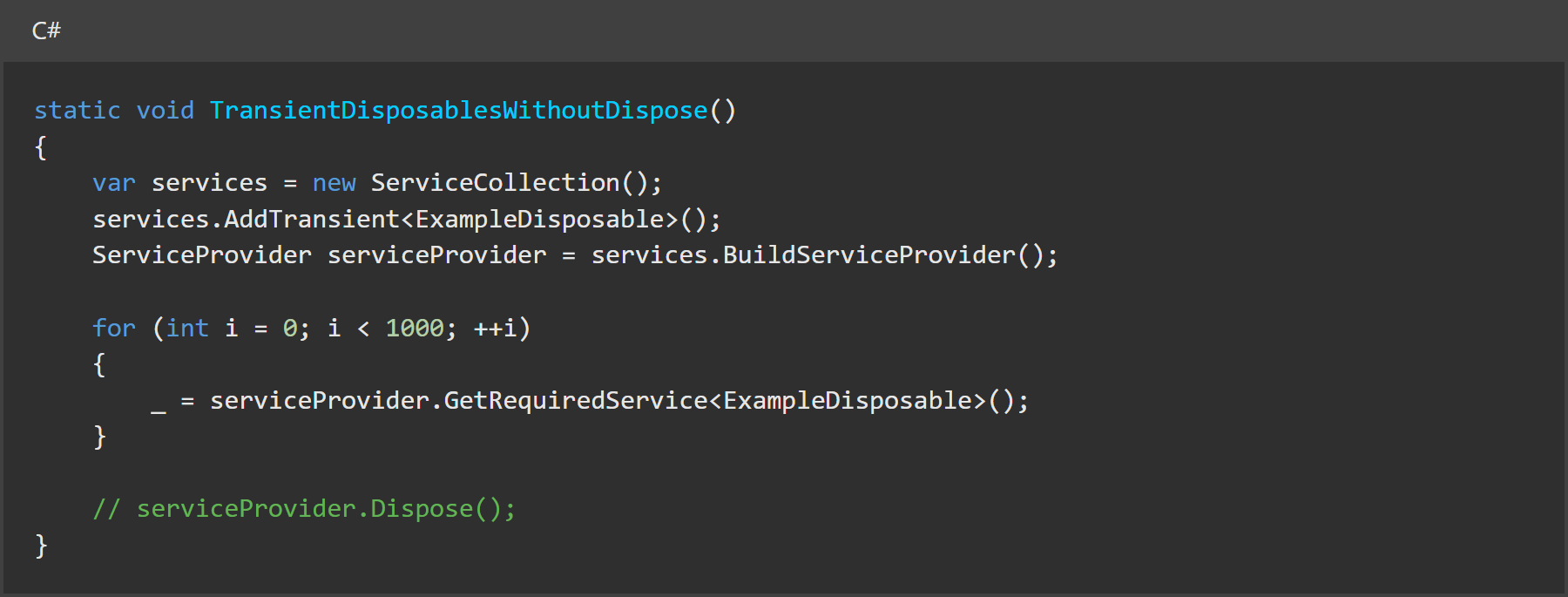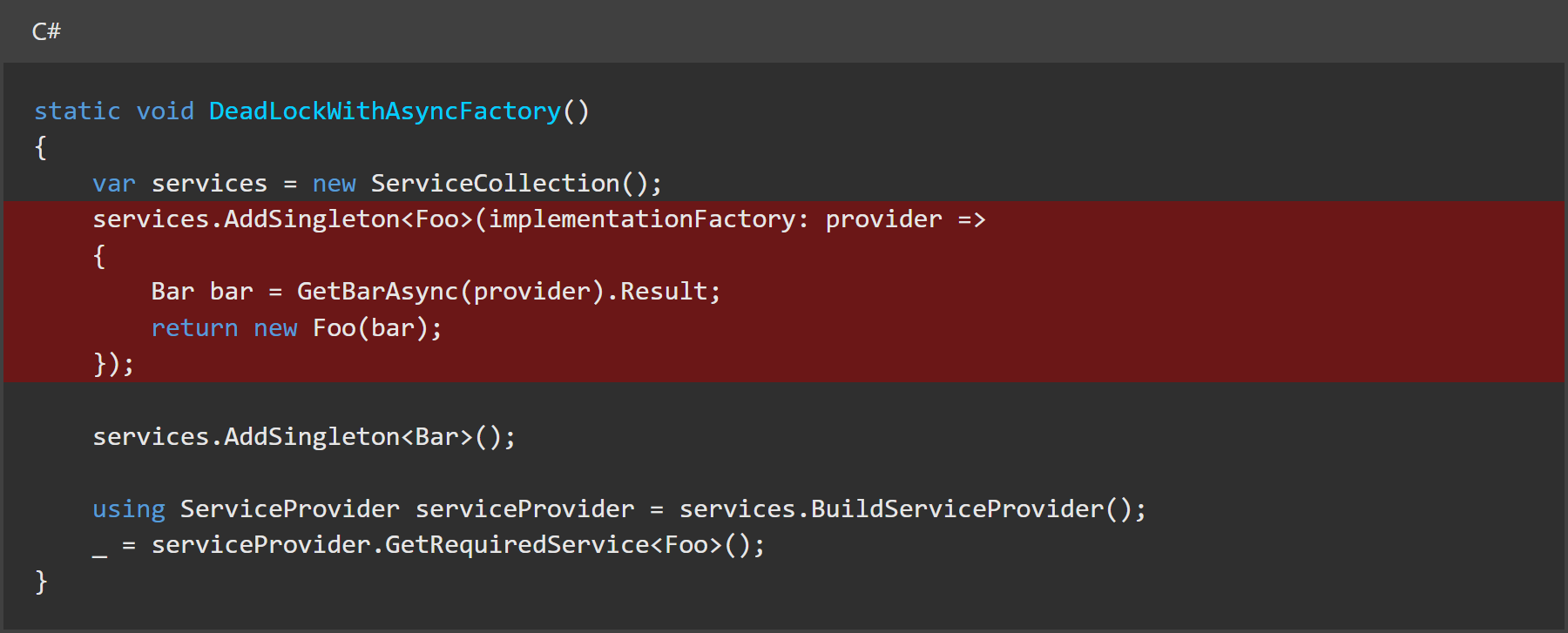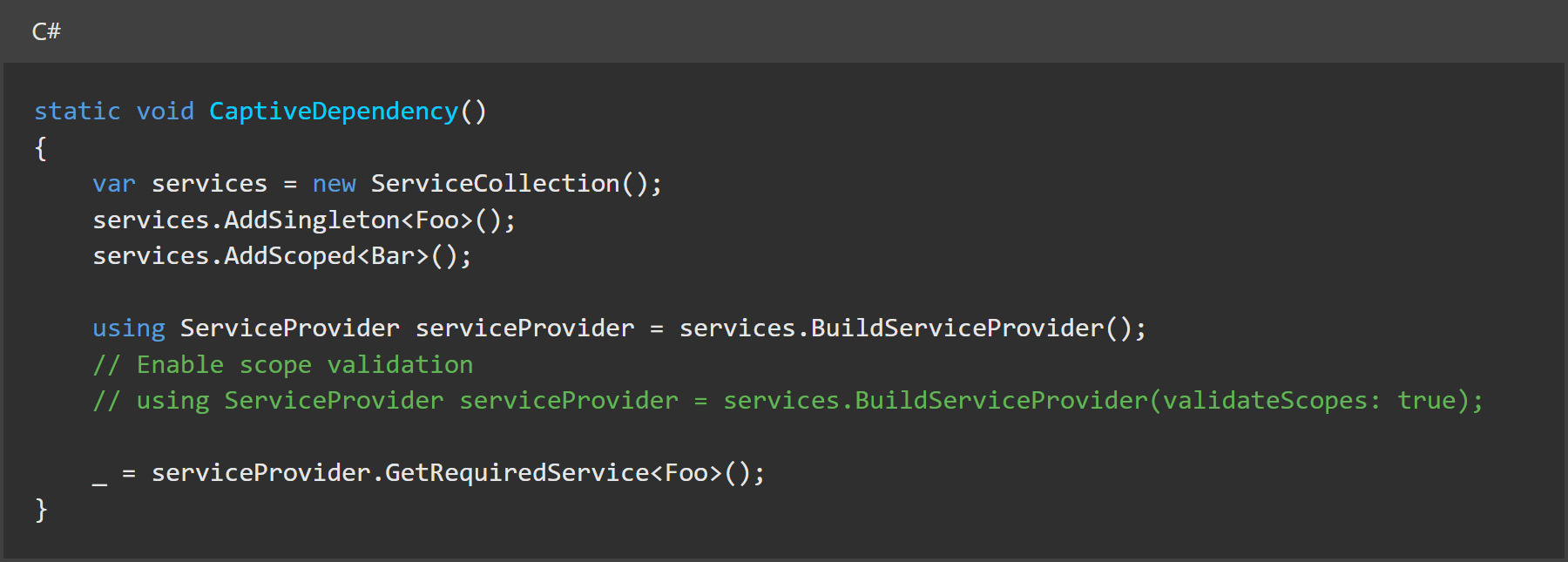Note
Access to this page requires authorization. You can try signing in or changing directories.
Access to this page requires authorization. You can try changing directories.
This article provides general guidelines and best practices for implementing dependency injection (DI) in .NET applications.
Design services for dependency injection
When designing services for dependency injection:
- Avoid stateful, static classes and members. Avoid creating global state by designing apps to use singleton services instead.
- Avoid direct instantiation of dependent classes within services. Direct instantiation couples the code to a particular implementation.
- Make services small, well-factored, and easily tested.
If a class has many injected dependencies, it might be a sign that the class has too many responsibilities and violates the Single Responsibility Principle (SRP). Attempt to refactor the class by moving some of its responsibilities into new classes.
Disposal of services
The container is responsible for cleanup of types it creates, and calls Dispose on IDisposable instances. Services resolved from the container should never be disposed by the developer. If a type or factory is registered as a singleton, the container disposes the singleton automatically.
In the following example, the services are created by the service container and disposed automatically:
namespace ConsoleDisposable.Example;
public sealed class TransientDisposable : IDisposable
{
public void Dispose() => Console.WriteLine($"{nameof(TransientDisposable)}.Dispose()");
}
The preceding disposable is intended to have a transient lifetime.
namespace ConsoleDisposable.Example;
public sealed class ScopedDisposable : IDisposable
{
public void Dispose() => Console.WriteLine($"{nameof(ScopedDisposable)}.Dispose()");
}
The preceding disposable is intended to have a scoped lifetime.
namespace ConsoleDisposable.Example;
public sealed class SingletonDisposable : IDisposable
{
public void Dispose() => Console.WriteLine($"{nameof(SingletonDisposable)}.Dispose()");
}
The preceding disposable is intended to have a singleton lifetime.
using ConsoleDisposable.Example;
using Microsoft.Extensions.DependencyInjection;
using Microsoft.Extensions.Hosting;
HostApplicationBuilder builder = Host.CreateApplicationBuilder(args);
builder.Services.AddTransient<TransientDisposable>();
builder.Services.AddScoped<ScopedDisposable>();
builder.Services.AddSingleton<SingletonDisposable>();
using IHost host = builder.Build();
ExemplifyDisposableScoping(host.Services, "Scope 1");
Console.WriteLine();
ExemplifyDisposableScoping(host.Services, "Scope 2");
Console.WriteLine();
await host.RunAsync();
static void ExemplifyDisposableScoping(IServiceProvider services, string scope)
{
Console.WriteLine($"{scope}...");
using IServiceScope serviceScope = services.CreateScope();
IServiceProvider provider = serviceScope.ServiceProvider;
_ = provider.GetRequiredService<TransientDisposable>();
_ = provider.GetRequiredService<ScopedDisposable>();
_ = provider.GetRequiredService<SingletonDisposable>();
}
The debug console shows the following sample output after running:
Scope 1...
ScopedDisposable.Dispose()
TransientDisposable.Dispose()
Scope 2...
ScopedDisposable.Dispose()
TransientDisposable.Dispose()
info: Microsoft.Hosting.Lifetime[0]
Application started.Press Ctrl+C to shut down.
info: Microsoft.Hosting.Lifetime[0]
Hosting environment: Production
info: Microsoft.Hosting.Lifetime[0]
Content root path: .\configuration\console-di-disposable\bin\Debug\net5.0
info: Microsoft.Hosting.Lifetime[0]
Application is shutting down...
SingletonDisposable.Dispose()
Services not created by the service container
Consider the following code:
// Register example service in IServiceCollection.
builder.Services.AddSingleton(new ExampleService());
In the preceding code:
- The
ExampleServiceinstance is not created by the service container. - The framework does not dispose of the services automatically.
- The developer is responsible for disposing the services.
IDisposable guidance for transient and shared instances
Transient, limited lifetime
Scenario
The app requires an IDisposable instance with a transient lifetime for either of the following scenarios:
- The instance is resolved in the root scope (root container).
- The instance should be disposed before the scope ends.
Solution
Use the factory pattern to create an instance outside of the parent scope. In this situation, the app generally has a Create method that calls the final type's constructor directly. If the final type has other dependencies, the factory can:
- Receive an IServiceProvider in its constructor.
- Use ActivatorUtilities.CreateInstance to instantiate the instance outside of the container, while using the container for its dependencies.
Shared instance, limited lifetime
Scenario
The app requires a shared IDisposable instance across multiple services, but the IDisposable instance should have a limited lifetime.
Solution
Register the instance with a scoped lifetime. Use IServiceScopeFactory.CreateScope to create a new IServiceScope. Use the scope's IServiceProvider to get required services. Dispose the scope when it's no longer needed.
General IDisposable guidelines
- Don't register IDisposable instances with a transient lifetime. Use the factory pattern instead so the solved service can be manually disposed when it's no longer in use.
- Don't resolve IDisposable instances with a transient or scoped lifetime in the root scope. The only exception to this is if the app creates or recreates and disposes IServiceProvider, but this isn't an ideal pattern.
- Receiving an IDisposable dependency via DI doesn't require that the receiver implement IDisposable itself. The receiver of the IDisposable dependency shouldn't call Dispose on that dependency.
- Use scopes to control the lifetimes of services. Scopes aren't hierarchical, and there's no special connection among scopes.
For more information on resource cleanup, see Implement a Dispose method or Implement a DisposeAsync method. Additionally, consider the Disposable transient services captured by container scenario as it relates to resource cleanup.
Default service container replacement
The built-in service container is designed to serve the needs of the framework and most consumer apps. We recommend using the built-in container unless you need a specific feature that it doesn't support, such as:
- Property injection
- Child containers
- Custom lifetime management
Func<T>support for lazy initialization- Convention-based registration
The following third-party containers can be used with ASP.NET Core apps:
Thread safety
Create thread-safe singleton services. If a singleton service has a dependency on a transient service, the transient service might also require thread safety depending on how it's used by the singleton. The factory method of a singleton service, such as the second argument to AddSingleton<TService>(IServiceCollection, Func<IServiceProvider,TService>), doesn't need to be thread-safe. Like a type (static) constructor, it's guaranteed to be called only once by a single thread.
Additionally, the process of resolving services from the built-in .NET dependency injection container is thread-safe.
Once an IServiceProvider or IServiceScope has been built, it's safe to resolve services concurrently from multiple threads.
Note
Thread safety of the DI container itself only guarantees that constructing and resolving services is safe. It doesn't make the resolved service instances themselves thread-safe.
Any service (especially singletons) that holds shared mutable state must implement its own synchronization logic if accessed concurrently.
Recommendations
async/awaitandTaskbased service resolution isn't supported. Because C# doesn't support asynchronous constructors, use asynchronous methods after synchronously resolving the service.- Avoid storing data and configuration directly in the service container. For example, a user's shopping cart shouldn't typically be added to the service container. Configuration should use the options pattern. Similarly, avoid "data holder" objects that only exist to allow access to another object. It's better to request the actual item via DI.
- Avoid static access to services. For example, avoid capturing IApplicationBuilder.ApplicationServices as a static field or property for use elsewhere.
- Keep DI factories fast and synchronous.
- Avoid using the service locator pattern. For example, don't invoke GetService to obtain a service instance when you can use DI instead.
- Another service locator variation to avoid is injecting a factory that resolves dependencies at runtime. Both of these practices mix Inversion of Control strategies.
- Avoid calls to BuildServiceProvider when configuring services. Calling
BuildServiceProvidertypically happens when the developer wants to resolve a service when registering another service. Instead, use an overload that includes theIServiceProviderfor this reason. - Disposable transient services are captured by the container for disposal. This can turn into a memory leak if resolved from the top-level container.
- Enable scope validation to make sure the app doesn't have singletons that capture scoped services. For more information, see Scope validation.
- Only use singleton lifetime for services with their own state that is expensive to create or globally shared. Avoid using singleton lifetime for services that have no state themself. Most .NET IoC containers use "Transient" as the default scope. Considerations and drawbacks of singletons:
- Thread safety: A singleton must be implemented in a thread-safe way.
- Coupling: It can couple otherwise unrelated requests.
- Testing challenges: Shared state and coupling can make unit testing more difficult.
- Memory impact: A singleton may keep a large object graph alive in memory for the lifetime of the application.
- Fault tolerance: If a singleton or any part of its dependency tree fails, it can't easily recover.
- Configuration reloading: Singletons generally can't support "hot reload" of configuration values.
- Scope leakage: A singleton can inadvertently capture scoped or transient dependencies, effectively promoting them to singletons and causing unintended side effects.
- Initialization overhead: When resolving a service, the IoC container needs to look up the singleton instance. If it doesn't already exist, it needs to create it in a thread-safe manner. In contrast, a stateless transient service is very cheap to create and destroy.
Like all sets of recommendations, you might encounter situations where ignoring a recommendation is required. Exceptions are rare, and are mostly special cases within the framework itself.
DI is an alternative to static/global object access patterns. You might not realize the benefits of DI if you mix it with static object access.
Example anti-patterns
In addition to the guidelines in this article, there are several anti-patterns you should avoid. Some of these anti-patterns are learnings from developing the runtimes themselves.
Warning
These are example anti-patterns. Do not copy the code, do not use these patterns, and avoid these patterns at all costs.
Disposable transient services captured by container
When you register transient services that implement IDisposable, by default the DI container holds onto these references. It doesn't dispose of them until the container is disposed when application stops if they were resolved from the container, or until the scope is disposed if they were resolved from a scope. A memory leak can result if resolved from container level.
In the preceding anti-pattern, 1,000 ExampleDisposable objects are instantiated and rooted. They won't be disposed of until the serviceProvider instance is disposed.
For more information on debugging memory leaks, see Debug a memory leak in .NET.
Async DI factories can cause deadlocks
The term "DI factories" refers to the overload methods that exist when calling Add{LIFETIME}. There are overloads that accept a Func<IServiceProvider, T> where T is the service being registered, and the parameter is named implementationFactory. The implementationFactory can be provided as a lambda expression, local function, or method. If the factory is asynchronous, and you use Task<TResult>.Result, it will cause a deadlock.
In the preceding code, the implementationFactory is given a lambda expression where the body calls Task<TResult>.Result on a Task<Bar> returning method. This causes a deadlock. The GetBarAsync method simply emulates an asynchronous work operation with Task.Delay, and then calls GetRequiredService<T>(IServiceProvider).
For more information on asynchronous guidance, see Asynchronous programming: Important info and advice. For more information debugging deadlocks, see Debug a deadlock in .NET.
When you're running this anti-pattern and the deadlock occurs, you can view the two threads waiting from Visual Studio's Parallel Stacks window. For more information, see View threads and tasks in the Parallel Stacks window.
Captive dependency
The term "captive dependency", coined by Mark Seemann, refers to the misconfiguration of service lifetimes, where a longer-lived service holds a shorter-lived service captive.
In the preceding code, Foo is registered as a singleton and Bar is scoped - which on the surface seems valid. However, consider the implementation of Foo.
namespace DependencyInjection.AntiPatterns;
public class Foo(Bar bar)
{
}
The Foo object requires a Bar object, and since Foo is a singleton, and Bar is scoped, this is a misconfiguration. As is, Foo is only instantiated once, and it holds onto Bar for its lifetime, which is longer than the intended scoped lifetime of Bar. Consider validating scopes by passing validateScopes: true to the BuildServiceProvider(IServiceCollection, Boolean). When you validate the scopes, you get an InvalidOperationException with a message similar to "Cannot consume scoped service 'Bar' from singleton 'Foo'.".
For more information, see Scope validation.
Scoped service as singleton
When using scoped services, if you're not creating a scope or within an existing scope, the service becomes a singleton.
In the preceding code, Bar is retrieved within an IServiceScope, which is correct. The anti-pattern is the retrieval of Bar outside of the scope, and the variable is named avoid to show which example retrieval is incorrect.





